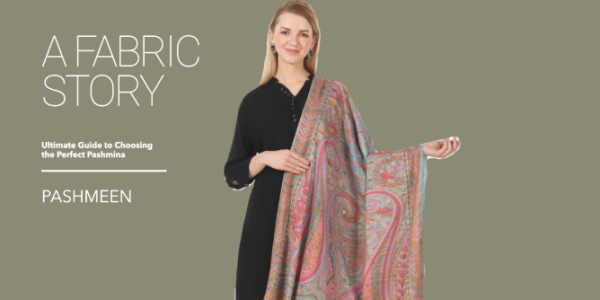THIS IS A DEMO WEBSITE!
This is a demo site for testing purpose only. Do not buy anything on this website.
Go to Live Website - www.pashmeen.com
This is a demo site for testing purpose only. Do not buy anything on this website.
Go to Live Website - www.pashmeen.com

The article discusses cashmere pashmina, a pricey textile manufactured from the silky undercoat of the Cashmere goat. The several kinds of cashmere pashmina accessories—including scarves, shawls, stoles, and mufflers—and how they may warm up and dress up any outfit are covered in the article. Also, it includes maintenance advice for your cashmere pashmina accessories, such as hand washing in cold water, air drying, and storage in a cool, dry area.
Read more
The Ultimate Guide to Choosing the Perfect Pashmina: A Fabric Story" is an in-depth exploration of various fabrics, including Pashmina, Cashmere, Wool, Silk, Bamboo, and Modal. The article guides readers through the unique qualities, origins, and textures of each fabric, helping them make informed choices. From the luxury of Pashmina to the eco-friendliness of Bamboo, the guide covers it all. Practical advice on occasions to wear each fabric and detailed washcare tips add a valuable layer to the narrative.
Read moreDelve into the fascinating history of pashmina embroidery. Explore the origins, techniques, and significance of this exquisite craft. From intricate designs to cultural symbolism, learn how pashmina embroidery has evolved through the ages. Discover the beauty and artistry behind this cherished tradition.

Pashmina, the soft and luxurious fabric known for its warmth and elegance, is further enhanced by the art of embroidery. Pashmina embroidery is a centuries-old craft that holds deep cultural and historical significance. In this article, we will take you on a journey through time as we uncover the captivating history of pashmina embroidery. From its origins in the Kashmir region to the intricate designs and skilled craftsmanship, we will explore the beauty and cultural richness behind this cherished tradition.
1. The Kashmir Connection: The art of pashmina embroidery finds its roots in the scenic valley of Kashmir, nestled in the Himalayas. The region's rich cultural heritage and the availability of fine pashmina wool make it the perfect breeding ground for this exquisite craft. Kashmiri artisans have mastered the art of embroidery over centuries, passing down their skills from one generation to the next.
2. Influence of Mughal Era: Pashmina embroidery flourished during the Mughal era in the 16th century. The Mughal emperors, known for their patronage of arts and crafts, greatly influenced the development and refinement of embroidery techniques. Intricate designs, delicate threadwork, and rich colors became hallmarks of Mughal-inspired pashmina embroidery.
1. Chain Stitch: Chain stitch is one of the primary techniques used in pashmina embroidery. This stitch creates a chain-like effect, forming intricate patterns and motifs on the fabric. The use of vibrant colored threads adds depth and beauty to the embroidery.
2. Aari Work: Aari work is another popular technique employed in pashmina embroidery. It involves using a special hooked needle called an "aari" to create fine, detailed patterns. This technique allows for precision and intricacy, resulting in stunning designs that adorn pashmina shawls and garments.
3. Jamawar: Jamawar is a distinct style of pashmina embroidery that originated in Kashmir. It features a combination of intricate weaving and embroidery, resulting in elaborate and symmetrical designs. Jamawar shawls are highly sought after for their exquisite craftsmanship and timeless elegance.
1. Heritage and Tradition: Pashmina embroidery represents the cultural heritage and traditional craftsmanship of the Kashmir region. It reflects the skills passed down through generations, preserving the artistry and techniques that make each piece a work of art.
2. Symbolism and Stories: Pashmina embroidery often incorporates symbolic motifs that tell stories or convey cultural significance. These motifs can depict elements from nature, historical events, or religious beliefs. Each stitch carries meaning and adds depth to the narrative of the embroidered piece.
Q1: Is pashmina embroidery done by hand or machine?
A1: Pashmina embroidery is primarily done by hand. The intricate designs and delicate nature of pashmina fabric require the skill and precision of artisanal craftsmanship. Hand embroidery ensures the highest level of detail and quality.
Q2: Can pashmina embroidery be customized?
A2: Yes, pashmina embroidery can be customized according to personal preferences. Artisans can create bespoke designs based on individual requests, allowing for unique and personalized pieces.
Q3: Is pashmina embroidery limited to shawls and garments?
A3: While pashmina embroidery is commonly seen on shawls and garments, it can also be found on other accessories such as scarves, stoles, and even home decor items like cushion covers and wall hangings.
Pashmina embroidery is an art form that weaves together the threads of history, culture, and skilled craftsmanship. Its origins in the Kashmir region and its influence from the Mughal era have shaped it into the exquisite craft we admire today. From the intricate chain stitches to the precision of aari work, pashmina embroidery showcases the dedication and talent of Kashmiri artisans. Its cultural significance and symbolic motifs make each piece a testament to the rich heritage it represents. As you wrap yourself in the warmth and beauty of a pashmina adorned with embroidery, you become part of a timeless tradition that connects the past with the present.
Save products on your wishlist to buy them later or share with your friends.
iqitcookielaw - module, put here your own cookie law text
